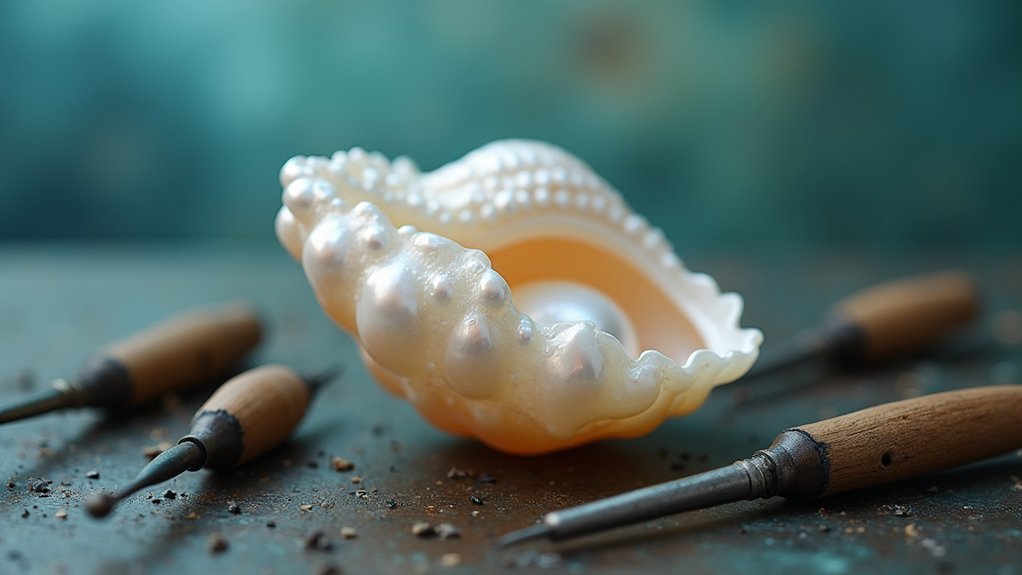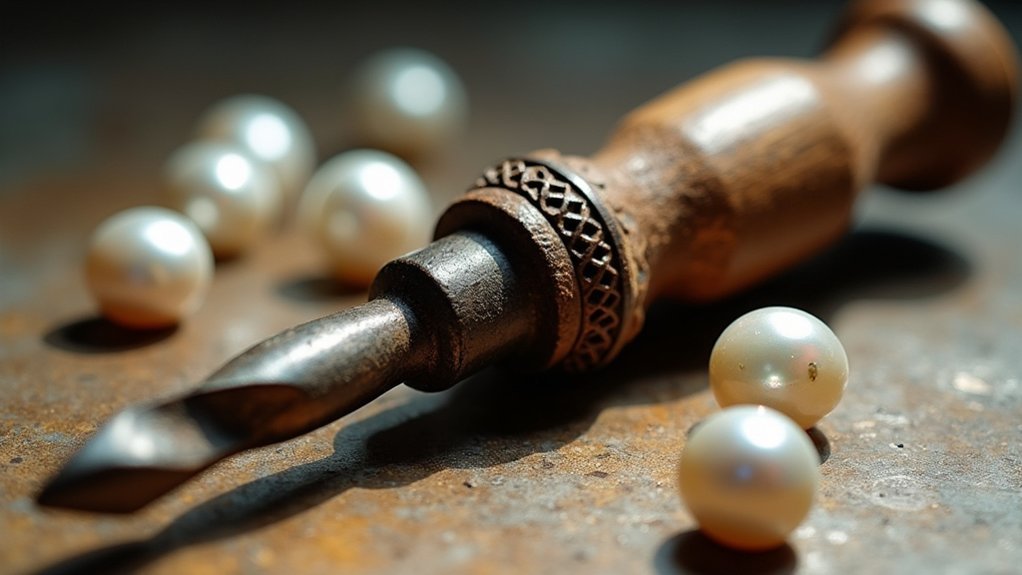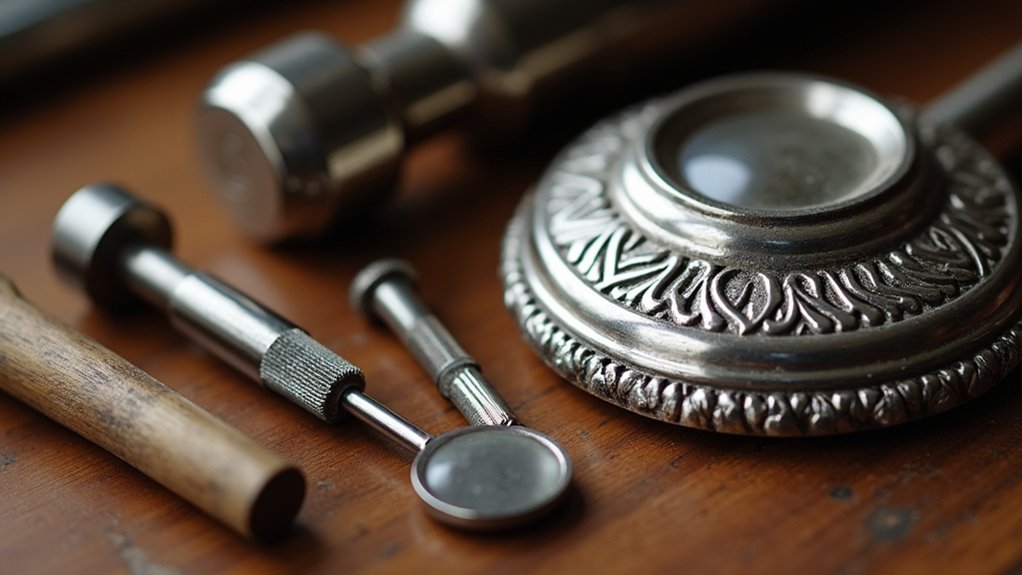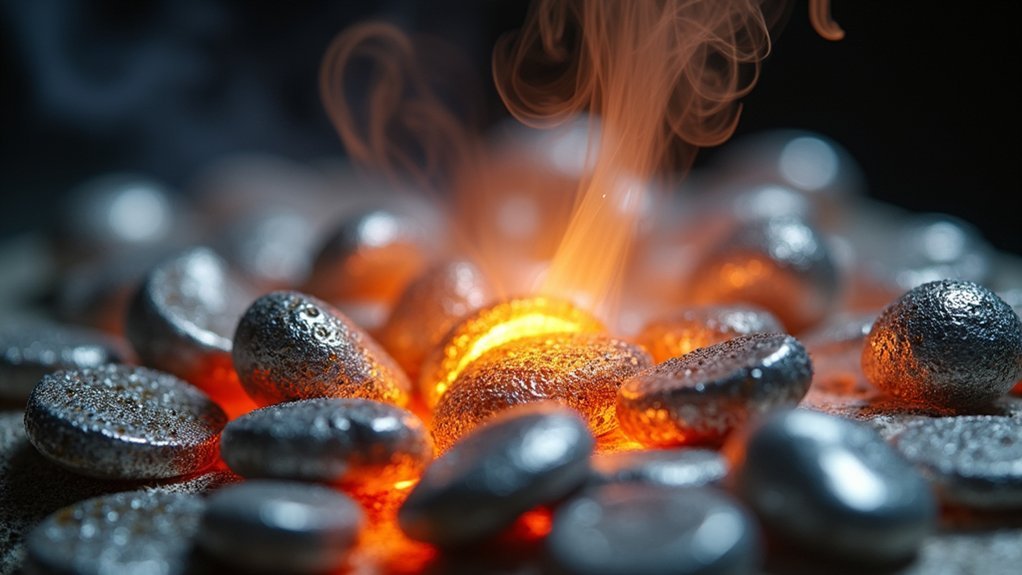Pearl drilling techniques were essential because they transformed pearls from simple curiosities into sophisticated jewelry that symbolized wealth and status across civilizations. You’ll find that these innovations enabled artisans to create intricate necklaces and customized pieces, revolutionizing global trade networks and luxury markets. The techniques boosted pearl marketability, supported entire coastal communities economically, and allowed for complex designs that defined cultural prestige. The full story reveals how these methods shaped ancient commerce and modern jewelry traditions.
Historical Development of Pearl Perforation Methods

While ancient jewelers possessed considerable skill in crafting ornate pieces, their rudimentary pearl drilling techniques often damaged the delicate nacre layers due to imprecise tools and limited understanding of pearl structure.
You’ll find that pearl perforation methods transformed dramatically by the 19th century when specialized drill bits revolutionized drilling technology. These advancements allowed craftsmen to create precise, clean holes without compromising pearl integrity.
Specialized drill bits of the 19th century revolutionized pearl perforation, enabling craftsmen to create precise holes without damaging delicate pearl integrity.
The shift from manual drills to electric drills marked a pivotal moment in pearl jewelry production. Electric drills provided consistent accuracy and speed that manual methods couldn’t match.
Modern techniques incorporate water cooling systems that prevent overheating and cracking during perforation. These improvements didn’t just enhance aesthetic appeal—they markedly boosted the marketability of pearls by enabling easier stringing and integration into diverse jewelry designs.
Cultural and Economic Significance of Drilled Pearl Jewelry
The transformation of pearl drilling techniques released profound cultural and economic forces that reshaped societies worldwide.
You’ll find that drilled pearl jewelry carries deep cultural significance, symbolizing wealth and status across Asian societies where pearls represent good fortune. These techniques enabled artisans to create customized jewelry with intricate designs, driving demand in the luxury market and supporting local economies globally.
Traditional crafts flourished as pearl drilling techniques allowed communities to express their heritage through ceremonial adornments.
You can see how this skill became essential for artisan livelihoods, particularly in handmade jewelry sectors. The economic value extends beyond individual pieces—entire communities depend on these techniques for sustainability, while the growing market for personalized drilled pearl jewelry continues generating significant revenue worldwide.
Technical Innovations in Ancient Pearl Drilling Tools

Behind every exquisite piece of drilled pearl jewelry lies centuries of remarkable tool innovation that transformed how artisans approached their craft.
You’ll discover that ancient pearl drills evolved from simple wooden implements to sophisticated spring-pole systems that revolutionized drilling efficiency. These specialized tools were designed specifically for natural pearls’ delicate nacre, requiring precision you can’t achieve with standard drilling equipment.
Ancient pearl drilling transformed from basic wooden tools to revolutionary spring-pole systems, creating specialized equipment that standard drills simply couldn’t match.
The spring-pole method introduced a weighted drilling motion that greatly improved your ability to create clean holes without damaging the pearl’s lustrous surface.
Early craftsmen developed metal and wooden drill bits tailored specifically for pearls’ softer composition. Water circulation techniques later enhanced these drilling processes, allowing you to cool the pearl and remove debris effectively.
These innovations enabled artisans to create intricate jewelry designs that expanded pearl markets considerably.
Regional Variations in Pearl Drilling Practices
Across different pearl-producing regions, you’ll find that drilling techniques have evolved to match the unique characteristics of local pearl varieties.
In Japan, you’ll see specialized equipment designed for Akoya pearl drilling that preserves their delicate nacre and exceptional luster.
Australia’s approach focuses on South Sea pearls, using larger drill bits to handle thicker nacre layers while preventing damage.
Tahitian pearl processors embrace hand-drilling methods that showcase artisan craftsmanship and honor cultural traditions in their pearl jewelry creation.
These regional variations reflect how local resources influence tools and techniques.
You’ll notice advanced regions use diamond and hardened steel drill bits, while areas with limited equipment adapt their methods.
Whether processing freshwater pearls or saltwater pearls, each region’s unique approach guarantees optimal outcomes.
Impact on Trade Routes and Jewelry Distribution Networks

When pearl drilling techniques advanced beyond basic piercing methods, they fundamentally transformed global commerce by creating sophisticated trade networks that connected pearl-harvesting regions with luxury markets worldwide.
You’ll find that these innovations enabled jewelers to string drilled pearls together effortlessly, producing intricate pearl jewelry designs that captivated European buyers. As advancements in drilling technology accelerated production speeds, jewelry distribution networks expanded dramatically from the Persian Gulf and South Seas to international markets.
The refined drilling processes allowed for larger, more complex pearl necklaces, increasing trade volumes across cultures.
You can see how this demand drove economic development in coastal communities, where pearl harvesting and jewelry making became cornerstones of international commerce, establishing these regions as crucial players in global trade routes.
Frequently Asked Questions
What Is the Most Important Factor in Correct Drilling Technique?
You’ll achieve the best drilling results when you make certain the drill meets precisely in the pearl’s center. This technique prevents cracking and guarantees proper alignment for stringing, making it drilling’s most critical factor.
Can You Drill Through a Real Pearl?
You can drill through a real pearl, but you’ll need specialized three-sided drill bits and precise techniques. You must drill slowly to prevent overheating and cracking the delicate nacre surface.
What Techniques Were Used in Early Oil Drilling?
You’d use spring-pole techniques with percussion bits and manual strength for early drilling. Cable tool drilling powered by steam became standard, while water circulation methods greatly increased your drilling speed and efficiency.
What Is the Purpose of Drilling a Pilot Hole When Drilling?
You’ll drill a pilot hole to create precise alignment and prevent cracking. It guides larger bits accurately, removes debris efficiently, maintains center positioning, and lets you gradually increase hole size safely.
In Summary
You can see how pearl drilling techniques revolutionized ancient jewelry making by enabling standardized stringing methods that expanded global trade networks. You’ll find these innovations didn’t just improve craftsmanship—they transformed pearls from loose decorative objects into sophisticated wearable art. The technical mastery required for clean perforation without cracking delicate nacre surfaces established specialized artisan classes across cultures. These drilling methods ultimately determined which civilizations could participate in lucrative pearl commerce routes.





Leave a Reply